
Centre of Jaina Studies Newsletter: SOAS - University of London
J aina art is included in many exhibitions of Indian art, particularly exhibits of painting. But it is extremely rare to have an exhibition that concentrates exclusively on Jainism, and the forthcoming exhibition at the Rubin Museum of Art in New York City will do just that. Organized by Phyllis Granoff, Victorious Ones: Jain Images of Perfection, will be on display from 18 September 2009 to 15 February 2010. There seems to have never been a major exhibition of Jaina art in India, perhaps since these works are objects of worship functioning in the everyday life of the Jaina community. By taking them out of their devotional context, the exhibition let's us appreciate them for their religious significance and aesthetic qualities at the same time.
To date only a few exhibitions of Jaina art have had accompanying catalogues. The most important, which exhibited the broadest range of material, was The Peaceful Liberators, Jain Art from India (1994) first seen in Los Angeles before it travelled to a few cities in the United States and then to the Victoria and Albert Museum in London. The next important exhibition was Steps to Liberation: 2,500 Years of Jain Art and Religion (2000) mounted in Antwerp. A third, with a published pamphlet, was an exhibit displayed at the New York Public Library during the US Festival of India in 1986. There have also been other small exhibitions. I curated two in San Francisco, and currently the Norton Simon Museum in Pasadena has mounted a small installation: On the Enlightened Path: Jain Art from India, on view through 13 July 2009. However, none of these have much published material about them.
The Victorious Ones: Jain Images of Perfection will have a lavishly illustrated catalogue featuring scholarly essays by John E. Cort, Paul Dundas, Phyllis Granoff, Julia Hegewald, Padmanabh S. Jaini, Kim Plofker, Sonya Quintanilla, and the present author. The exhibition will offer a mix of objects from northern and southern India: paintings on paper and cloth and sculptures made of stone and metal. Rather than repeat the items from the earlier exhibit from Los Angeles, this show consists of different material and focuses more particularly on images of the Jinas. Images of the Jinas exist throughout the cosmos and many of the works, chosen for their high aesthetic quality, offer representations meant for veneration in temples or domestic shrines, but also suggest the endless number of images spread all over the Jaina universe. The paintings included in the exhibition reflect a wider variety of styles than usual and offer additional aspects of Jaina religious art. These include narrative painting, paintings of cosmographic significance typified by Figure 1 which shows a diagram of the universe and the seven levels of the hells, and Figure 2 (see page 23) which depicts Mount Meru with some of the Jina temples on the terraces of that mythical mountain. There are also devotional images, including an important Digambara group from Mysore, represented here by Figures 3 and 4 to be described briefly below, and depictions of religious pilgrimage sites: Figure 5 depicts a group of temples of the five principle Jinas on the first page of a work praising the important pilgrimage site Śatruñjaya. A number of large cosmographs are also included in the show depicting the Aḍhāī-dvīpa, the two and a half continents, the world of man.
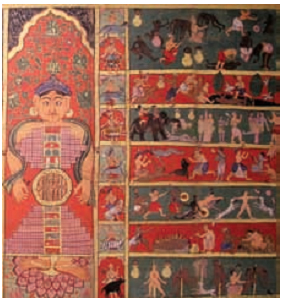
Fig.1 The Universe in the Shape of a Person and the Seven Levels of Hell Detail of Diagrams of the Universe Gujarat? dated Samvat 1670 (1613 A.D.) Ink and opaque watercolor on cloth Ralph and Catherine Benkaim Collection 33 x 61 inches (83.8 x 155 cm)
Since the Kalpasūtra tells Mahāvīra's life at greater length than that of the other Jinas, narrative paintings in the exhibition are confined to the telling of his life. The Kalpasūtra is amply represented by twelve folios, mostly in the usual Gujarati-Rajasthani style from across northern India, including some folios from a dispersed Kalpasūtra from Jaunpur as seen in Figure 6. It depicts the transfer of the embryo of Mahāvīra by Hariṇegameṣin.
The Śvetāmbaras believe that Mahāvīra was conceived by a Brahman lady, Devānandā, and that Indra, called Śakra in the Śvetāmbara tradition, sent the goatheaded demigod Hariṇegameṣin to transfer his embryo to the womb of a Kṣatrīya lady, Queen Triśalā. This transfer is not accepted by the Digambaras. In essence it was necessary for a proper birth, because all of the preceding Jinas had been born into the princely class. At the same time it gives Mahāvīra a sort of dual parentage, belonging to both of the higher castes.
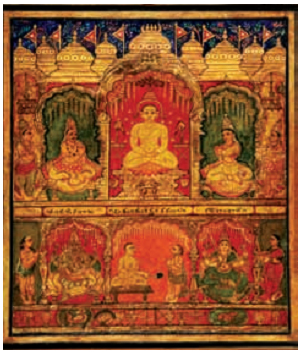
Fig. 3 Worship of the Jina Kunthu Karṇāṭaka, Mysore, ca. 1825-75 Ink, opaque water color, and gold on paper or board. Dr. Siddharth Bhansali Collection 11 ½ x 13 ½ inches (29.2 x 34.3 cm)
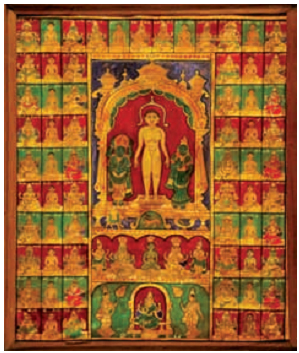
Fig. 4 Caturviṃśati with Mahāvīra and Pārśva in its center Karṇāṭaka, Mysore, ca. 1825-75 Ink, opaque water color, and gold on paper or board. Dr. Siddharth Bhansali Collection 19 x 23 inches (48.3 x 58.4 cm)
Contrasting with narrative works, other paintings in the exhibition serve cosmological and devotional purposes, and multiple Jinas are seen in a folio from a Śatruñjaya Māhātmya (fig. 5), as well as in the Saṃghayaṇarayaṇa (Skt. Saṃgrahāṇisūtra) folio (fig. 2 on page 23) and a painting of the Caturviṃśati (the twenty-four Jinas) from Mysore (fig. 4).
While Śvetāmbara illustrated manuscripts are quite numerous, Digambara ones are rare and although none are included in the exhibition, other Digambara works are on exhibit, coming from two distinct traditions. One is represented by a painting from an important northern Indian narrative series created at Amber ca.1680, which concerns the pañcakalyāṇaka (five auspicious events in the life of a tīrthaṅkara) of the first Jina Ṛṣabha. It appeared in last year's issue of the CoJS Newsletter on page 27. The stories told in that set can be related directly to Kalpasūtra paintings, since on the whole the themes are shared ones, but the compositional representations of these events are not necessarily the same. There is a paucity of available examples for such an exhibition and the most impressive Digambara manuscripts are in Indian temple collections. An essay on Digambara narrative of southern India, which will flesh out some of these differences, will be included in the catalogue.
The other Digambara tradition is represented by a group of five paintings from Karṇāṭaka dating from the nineteenth century (figs. 3 and 4). Rather than illustrate a narrative, the main purpose here is iconic. Similar devotional images are found in great abundance in northern India as well. The three central figures at the top of Figure 3 are labeled in Kannaḍa as Kunthu Tīrthaṅkara, the seventeenth Jina, and he is flanked by his parents Śrikāntādevī and Śūrasenarāja. Although unlabeled, his attendant śāsanadevatās Gāndharva and Vijayā are seen below on either side of a Digambara monk holding a broom, and facing a lay devotee. In turn the central groups are each flanked by a pair of figures, god-like crowned figures at the top, and a lay couple at the bottom. These are perhaps a suggestion of the couple that commissioned the work. The depiction of all twenty-four Jinas together (fig. 4), a caturviṃśati paṭa or cauvīsī is quite commonly found in both painting and sculpture. Mahāvīra, the principal figure at the centre standing in the kāyotsarga pose for meditation, is labeled as Vardhamāna, his given name. Pārśva is in the panel below Mahāvīra and the goddess at the bottom is Sarasvatī flanked by two female cauri bearers. The other twenty-two Jinas are placed in order reading clockwise from Ṛṣabha at the bottom left to Nemi at the bottom right. Only recently have representatives of the Digambara Jain tradition from the south been appearing in the art market. Most come from important centres in Karṇāṭaka, primarily Mysore and Śravaṇabelgoḷa.
Much of the sculpture in the show can be labeled as Digambara as well, although the actual distinction between sects is a later one; the Jinas in the earlier material are all naked, but not exclusively Digambara. A highlight of the Śvetāmbara tradition is a seated bronze image of the twenty-third Jina Pārśva (fig. 7) from the site of Akota, ancient Aṇkoṭṭaka, located west of the city of Vadodara (Baroda) in the western Indian state of Gujarat. Akota is the site where the most famous hoard of Jain bronzes was identified by U. P. Shah in 1951. Pārśva is identifiable by the snake hood behind him, and the surviving figure on Pārśva's right is the yakṣa Sarvānubhūti, who is said to hold a citron in his right hand and a bag of money in his left, though these objects are here somewhat indistinct. The figure in the Mysore painting (fig. 4) flanking Mahāvīra is the same yakṣa, who goes by a variety of names. Along the bottom of the sculpture are the navagraha or nine planets.
A highlight for Digambara sculpture in the exhibition is a Ṛṣabha now in the Yale University Art Gallery (fig. 8). He sits in meditation and is identifiable by the pair of bulls on the pedestal and his flowing locks of hair. Ṛṣabha is the only Jina shown with hair. Several reasons for this are given in the various versions of his life written by the two sects.
The entire exhibition will include some thirty sculptures and almost forty paintings. Along with the informed essays, the carefully chosen beautiful objects, which concentrate on the images of the Jinas and their placement throughout the cosmos, will add considerably to an understanding of Jaina art from throughout India.
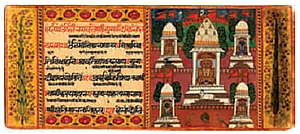
Fig. 5 Five Jinas Folio 1 (verso) from a Śatruñjaya māhātmya loose-leaf manuscript Rājasthān, Jaipur(?), ca. 1750 Ink, opaque watercolor, and gold on paper Private Collection 4 5/8 x 10 ¾ inches (11.6 x 27.2 cm)
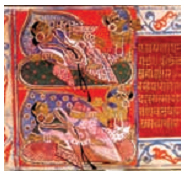
Fig. 6 The Transfer of the Embryo Folio 13 (recto) detail from a Kalpasūtra loose-leaf manuscript Western Indian Style, Uttar Pradeś, Jaunpur, ca. 1465 Ink, opaque watercolor, and gold on paper Ralph and Catherine Benkaim Collection
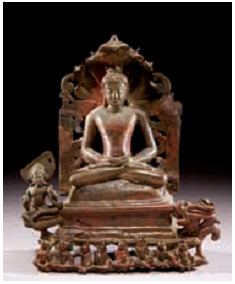
Fig. 7 Seated Pārśva Akota, Gujarat, India 7th century Bronze Dr. Siddharth Bhansali Collection 8 1/8 x 6 ¾ x 3 in
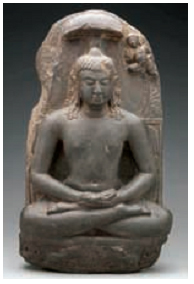
Fig. 8 Ṛṣabha Possibly Tetrāwāṅ, Patna District, Bihār Late 7th Century Black chlorite stone Yale University Art Gallery (Purchased with a gift from Steve M. Kossak) 2000.36.1 26 x 16x 5 inches (66 x 40.6 x 12.7 cm)
References:
Del Bontà, Robert J.,"Illustrating the Lives of the Jinas: Early Paintings from the Kalpasūtra,"in Jaina Studies: Newsletter of the Centre of Jaina Studies, March 2007, Issue 2, pp. 28-31.
Del Bontà, Robert J., "Lustrating the First King: Digambara Images of Abhiṣeka," Jaina Studies: Newsletter of the Centre of Jaina Studies, March 2008, Issue 2, pp. 22- 25, fig. 6, Rājyābhiṣekha of Ṛṣabha.
Pal, Pratapaditya, The Peaceful Liberators, Jain Art from India, Los Angeles: Los Angeles County Museum of Art, 1994.
Rosen, Elizabeth S., The world of Jainism: Indian manuscripts from the Spencer Collection, New York: New York Public Library, 1986.
Shah, Umakant Premanand, Akota Bronzes, Bombay: State Board for Historical Records and Ancient Monuments. Archaeological Series. no. 1, 1959.
Van Alphen, Jan, Steps to liberation: 2,500 years of Jain Art and Religion, Antwerp, Ethnografisch Museum, 2000.
Robert J. Del Bontà has lectured and published on a wide variety of subjects including Jaina art from all over India. He has curated many exhibits at the Asian Art Museum in San Francisco (including some on Jaina art) and major exhibitions at the University of California, Berkeley and the University of Michigan.
 Dr. Robert J. Del Bonta
Dr. Robert J. Del Bonta